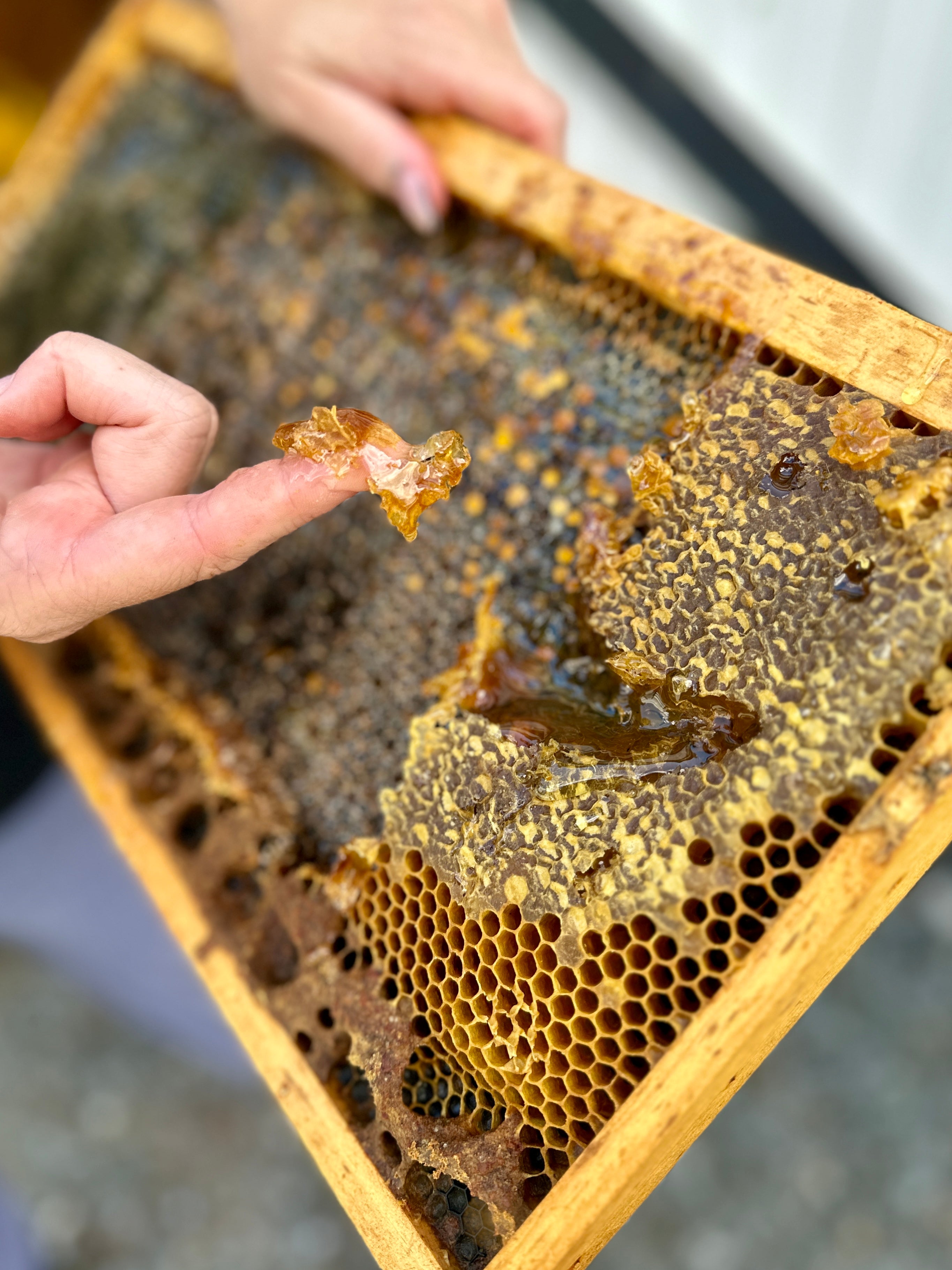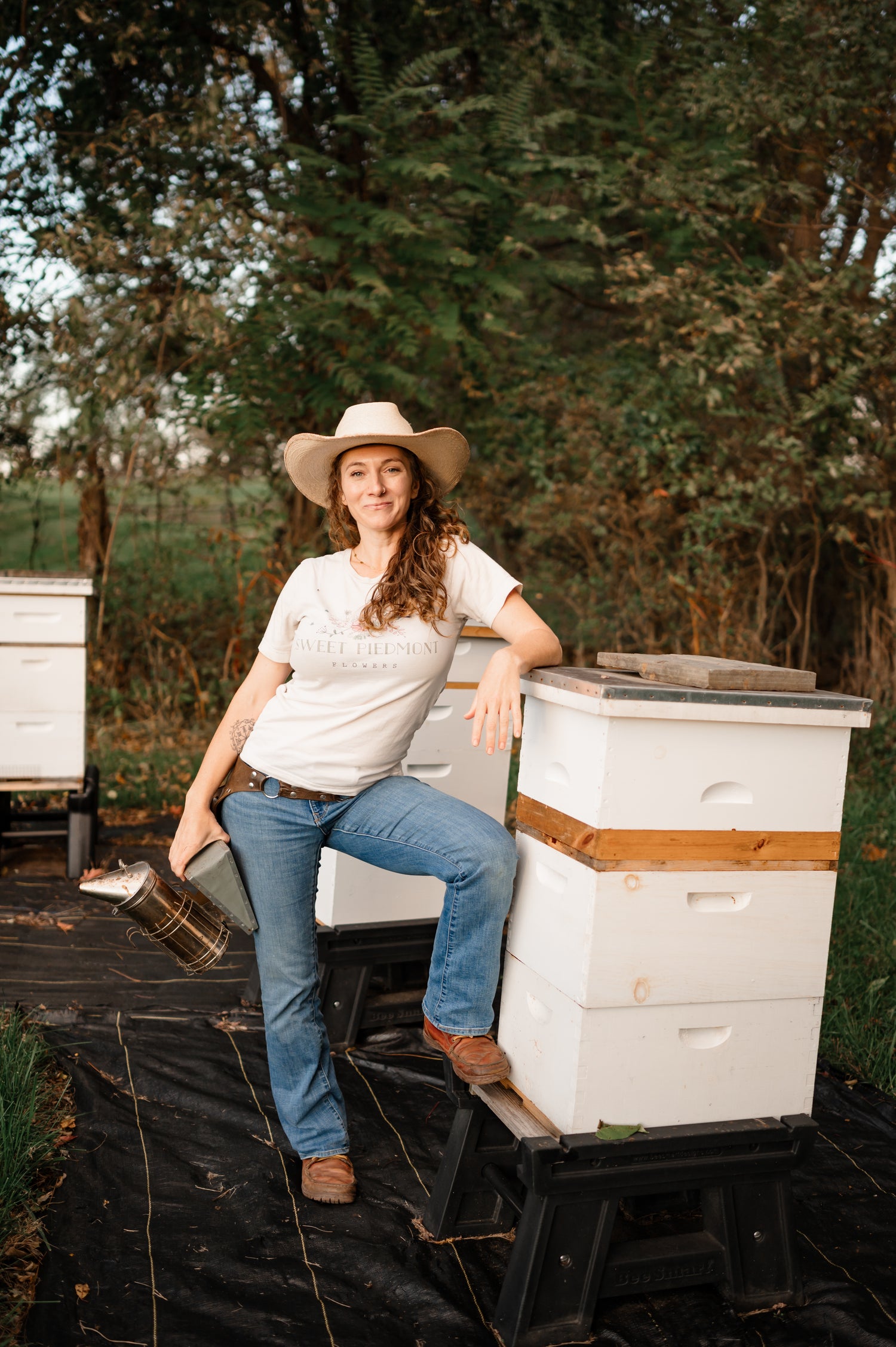
Sweet Rewards
There's Nothing Like Local Honey
There’s something magical about a jar of local honey. The golden syrup inside is more than just a natural sweetener, it’s a snapshot of a specific place and time. Every spoonful tells the story of the flowers that bloomed, the weather that shaped the season, and the tireless work of thousands of bees. In Loudoun County, small-scale beekeepers produce honey that captures the unique flavors of our Northern Virginia landscape, offering a fresher, richer, and often healthier alternative to supermarket brands. For those who care about supporting local agriculture and savoring nature’s best, understanding the journey of honey from hive to jar makes every drop even sweeter.
How Bees Make Honey (and Why They Deserve More Credit Than We Give Them)
Honey production starts with the humble but extraordinary honeybee. In Northern Virginia, most small-scale beekeepers work with the European honeybee (Apis mellifera), a species prized for its gentle nature and efficient honey production. Bees forage for nectar from flowers within a few miles of their hive, using their long, tube-like tongues to sip the sugary liquid and store it in a special “honey stomach.”
Back at the hive, the foragers pass the nectar to worker bees, who repeatedly regurgitate and re-chew it (not glamorous, but essential) to reduce its water content and mix in natural enzymes. These enzymes break down complex sugars into simpler sugars, which help prevent spoilage. The bees then deposit the nectar into hexagonal wax cells, fanning it with their wings to evaporate even more moisture until it thickens into honey. Finally, they cap each cell with beeswax, nature’s perfect storage system.
A single colony may have 50,000 to 60,000 bees working in harmony, each with specialized roles. The queen lays eggs, drones mate with queens from other colonies, and workers gather nectar, care for the brood, and defend the hive. The sheer organization and cooperation within a hive is a marvel of biology, and the reason humans have been able to partner with bees for thousands of years to enjoy their sweet product. Here at Sweet Piedmont, we keep anywhere from three to six hives in Waterford at any given time, depending on what the bees get up to each season.
We’re proud to grow such unique items right here in Loudoun County, Virginia. And we’re proud of the quality we produce. Our flowers are cultivated with care from tiny seed to beautiful bloom and they are picked with precision! Every stem in a Sweet Piedmont bouquet is hand selected for longevity and beauty, cut fresh to ensure the longest lifespan. This is perhaps the most important detail to consider when purchasing flowers - when was it harvested? Our blooms exceed or even double the lifespan of common florist flowers because of freshness alone.
What Local Honey Says About Loudoun's Weather
One of the most fascinating things about local honey from small-scale beekeepers in Loudoun County is that it changes flavor, aroma, and color depending on the season’s blooms and weather. Our hives are surrounded by abundant black locust trees, a highly sought-after nectar source, and our flower fields provide a rotating buffet of blooms for the bees. Sometimes they surprise us with their seasonal favorites.
In early spring, when dandelions, black locust, and fruit trees blossom, honey tends to be light in color with a delicate floral flavor. By late spring and early summer, tulip poplar and fruit trees dominate the nectar flow, producing a darker, more robust honey with caramel or molasses notes. Mid-summer honey might feature clover’s mild sweetness or the complexity of wildflowers, while late-season honey, when goldenrod and asters bloom, often has a stronger, more herbaceous taste.
Weather plays a huge role too. A rainy spring can limit foraging days but may lead to more nectar-rich flowers later. A dry summer might produce less nectar overall, leading to smaller harvests but sometimes more concentrated flavors. For beekeepers, each jar becomes a record of the year’s growing conditions, similar to a vineyard’s vintage but for honey.
If you were lucky enough to get a jar of 2024 Sweet Piedmont honey, you’ll note the color was a pale gold, almost clear. This year in 2025, our honey is much darker, reminiscent of molasses. The difference is that we had a very rainy May. The bees are used to rainy Aprils, but this year they were stuck inside during prime foraging days in that first good month out. Heavy rain can also wash nectar out of blossoms, forcing bees to rely on second- or third-choice flowers. All those small changes add up to a noticeably different honey.
Local vs. Supermarket Honey: The Real Differences
If you’ve only tasted honey from a supermarket squeeze bottle, you haven’t truly experienced what honey can be. While commercial honey is often blended from multiple regions or countries to achieve a consistent flavor and color, local honey is raw, unblended, and unique to a specific time and place.
Here’s how they differ:
- Processing:
Most store-bought honey is pasteurized, heated to high temperatures, to delay crystallization and kill yeast cells. Unfortunately, this also destroys some of honey’s beneficial enzymes, antioxidants, and subtle floral flavors. Local honey from small-scale producers is typically raw, meaning it’s strained to remove wax and debris but never heated enough to compromise its natural qualities. - Purity:
Some imported honey has been found to be adulterated with corn syrup or other sweeteners to cut costs. Reputable local beekeepers keep their honey pure, ensuring it’s just what the bees made, nothing added and nothing taken away. - Environmental Connection:
Buying local supports pollinator health in your own community. Your purchase helps maintain hives, plant pollinator-friendly flowers, and keep bee populations strong. Commercial honey may come from thousands of miles away, with little connection to our own Loudoun County ecosystem. - Flavor and Variety:
Because local honey reflects seasonal blooms, you’ll find flavors and colors you would never get from a standardized, blended product. It’s like the difference between eating a fresh, sun-warmed tomato from a backyard garden versus one shipped in from halfway around the world in winter.
The Sweet Conclusion: Why Going Local Is Worth It
Small-scale honey production in Loudoun County offers more than a jar of sweetness. It’s a relationship with nature, a taste of our local landscape, and a direct way to support sustainable agriculture. From understanding the intricate work of bees to tasting the year’s unique floral fingerprint, local honey connects us to the land in a way mass-produced honey never can.
If you’re ready to bring more of that goodness into your kitchen, here are a few simple and delicious ways to use local honey:
- Drizzle over yogurt or oatmeal for a naturally sweet breakfast.
- Stir into tea for a soothing, antioxidant-rich drink.
- Whisk into salad dressings with olive oil, mustard, and vinegar.
- Glaze roasted vegetables or meats for caramelized flavor.
- Spread on warm bread or biscuits for a simple, satisfying treat.
- Use in baking to add moisture and a subtle floral note to cakes and breads.
Whether you’re a casual honey lover or a budding beekeeper, choosing local means every jar you enjoy supports the bees, the flowers, and the people who make our community bloom. And that’s not just sweet, it’s worth savoring.

This Post Was Written By Our Lovely Beekeeper, Carla!
Carla has been part of the Sweet Piedmont team for nearly five years, wearing many hats and earning the title of our resident bee whisperer as she tends and nurtures our five bustling hives. When she’s not caring for the bees, she’s a true maven of the arts... welding, weaving, and woodworking her way through all kinds of creative and soulful pursuits!



